 Diato Manabe — YASKAWA ×
Rhizomatiks × ELEVENPLAY (Robot, drone, sensored space and coded visuals)
Diato Manabe — YASKAWA ×
Rhizomatiks × ELEVENPLAY (Robot, drone, sensored space and coded visuals)Media innovation does not happen in a silo. It happens in concert with emerging technology, advances in science, changes in the cultural sector, and thought leadership from many other fields of knowledge. Therefore, it is important to understand the suite of new technologies and innovations that are changing the human communication architecture and our social systems.
What are the media-related emerging technologies? How will they be used in society, industry and commerce? What is their economic value? Each month we look at a different category of technologies and share some of what we’re finding out about them. This month we’ll take a look at the Internet of Things.
One of the bleeding-edge areas of innovation in emerging media is happening in the area of connected objects and environments, also known as the “Internet of Things” (IoT). These range from smart homes, to connected cars, to bluetooth-enabled medical devices, to environmental sensors and well beyond. How will media makers communicate stories, share and gather information and generate experiences using IoT-enabled immersive and dynamic canvases?
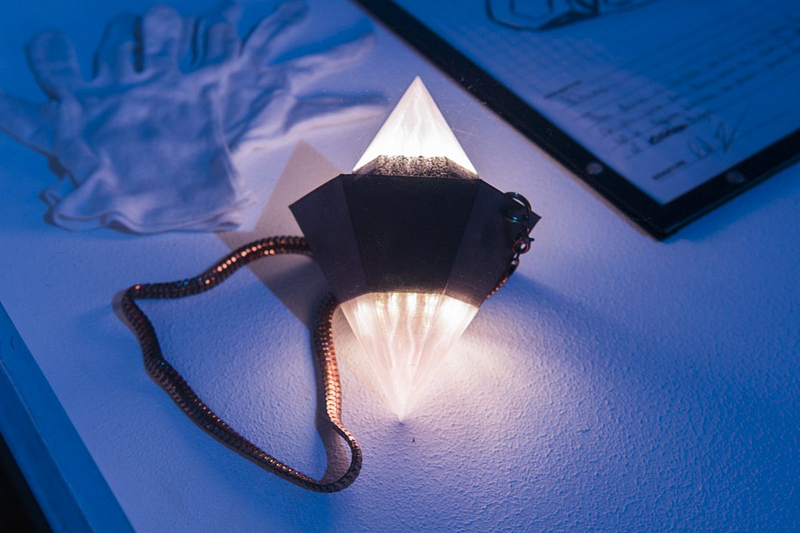 Iyapo Repository — Afrofuturist
Lantern
(Ambient Data Storytelling device)
Iyapo Repository — Afrofuturist
Lantern
(Ambient Data Storytelling device)We get a glimpse of where we are going in the work of artists such as Daito Manabe, Lauren McCarthy, Marshmallow Laser Feast, Salome Asega, Hyphen-Labs, John Kestner, and Lance Weiler. These artists are years ahead of audiences and industry, so we may not see a mass medium come out of these early experimentations for some time. However, predicting that there will be an IoT-related art form emerging for audiences is not that far-fetched when you think about the convergence of the exploding IoT industry and the experimentation of media makers with the new landscape it creates.
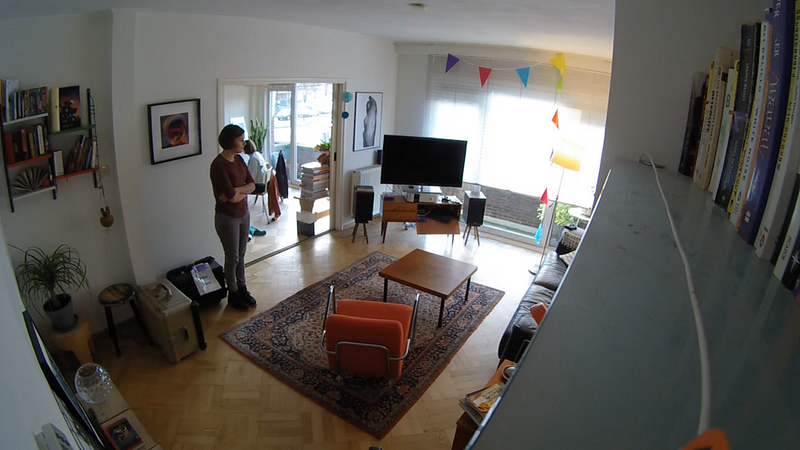 Lauren by Lauren McCarthy
(Wired Home w/ Human Interface AI)
Lauren by Lauren McCarthy
(Wired Home w/ Human Interface AI)What is IoT?
The IoT is a complex network of physical objects (the “things”) embedded with electronics, software, sensors, and network connectivity. These elements enable objects to collect and exchange data without a need for human interaction. — Nathan Sinnott, Chief Executive Officer of Newpath WEB (Entrepreneur.com)
This related is a suite of technologies is quickly coming to, or proliferating in, consumer markets. IoT breaks the Internet and smart technologies out of traditional screens such as desktop PCs, mobile devices, laptops. The 2017 and 2018 edition of CES allowed attendees to see this emerging architecture in greater detail. Saudi Gazette explains that “IoT may have been around for more than a decade, but it is only since the demand for mobile devices, faster broadband, drones, robotics, and the advent of smart home technologies that it has taken on a whole new lease of life.” AI is positioned to be the main driver of IoT technology, with wearables, voice command devices and AR as main interfaces, and blockchain as its security.
The devices are innumerable and span all industries, including smart homes, streets, entertainment venues, community spaces, stores and offices. Some popularly cited objects include: self-driving vehicles, drones, wearable fashion, digital personal assistants, facial recognition payment devices, in-home robots and smart appliances, handlebars for bikes and even smart mirrors. It is anticipated that the IoT global consumer markets will to grow from 15 billion smart objects in use in 2016 to 50 billion over the next three years. Even conservative projections suggest that there will be 21 billion IoT objects by 2020.
Essentially, humanity is building personal networked spaces and wired cities, where the Internet of Things is essential infrastructure, powered by intelligent algorithms. Futurists are imagining cities that have connected, intelligent objects that make an impact on transportation (self-driving cars — Google, Tesla, Uber), home robots and automation, healthcare (i.e., DIY eye exams, wearable trackers that allow diabetics to measure their glucose in real time without blood extraction), education, entertainment, low-resource communities support (equitable food distribution, predictive models to assist government agencies in prioritizing children at risk of lead poisoning), 4D virtual environments, public safety and security, employment and the workplace, fashion (wearables and textiles), toys, fitness, automatic shopping and replenishing (NFC and RFID), agriculture management, , environment management, and hospitality. DARPA is even developing the “ocean of things.”
Robots — an increasingly sophisticated and animate form of things — will play an ever-increasing role in our daily lives, from manufacturing automation to nanorobots used in healthcare. In one interesting example, Peter Thiel is an investor in a 15,000-square-foot lab in Emeryville, California, that remotely gives scientists access to robots. Clients may ask the robots to perform an experiment and share the results via the internet. One of the goals of this lab is to amass a huge amount of data from these experiments, in the hopes of finding correlations between experiments.
One insight that companies have identified about the public’s relationship to smart technology adoption is articulated by Ana Jorvick in the Harvard Business Review: “[D]espite the increased use of such technologies, consumers are not yearning for the robotic digitization of their everyday lives. Rather, they want technologies that weave themselves seamlessly into their activities. Consumers expect their digital experience to be more human and empathic, to be filled with emotional content, to surprise them with serendipitous occurrences, to allow for reciprocity and interactivity, and to offer the option of personalized adaptations.” This need for more sympatico devices opens up creative opportunities for artists and interface designers.
For example, some years ago, artist and MIT researcher Ben Rubin created a fleet of small robots that he unleashed at a public event. The robots, called BlabDroids, had large eyes and small bodies, and asked attendees emotionally probing questions in an innocent, childlike voice. Their intentionally manipulative design yielded unbelievable results — incredibly vulnerable videos of people truthfully answering the questions, while being recorded by each robot. Rubin’s experiment offered an important lesson about how humans could interact with smart objects. This is one example of how the infinitely dynamic and dimensional sandbox for creative media might emerge.
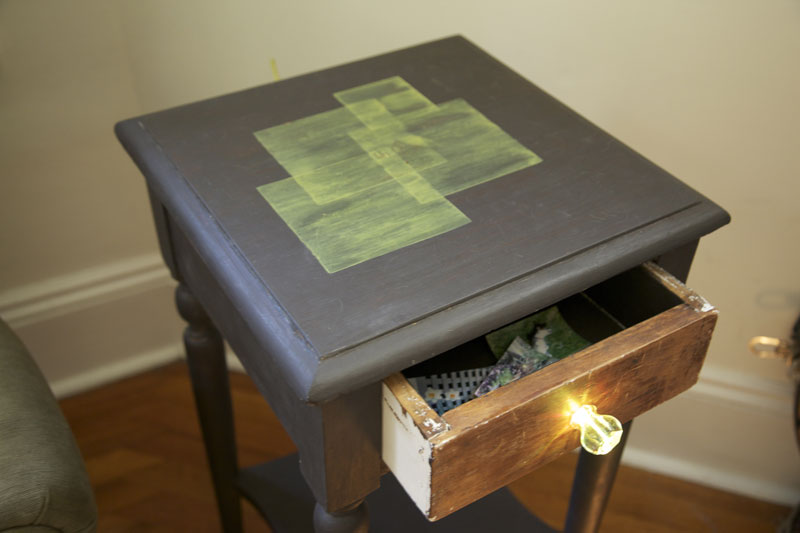 Tableau by John Kestner
(Physical email)
Tableau by John Kestner
(Physical email)So what is happening in the IoT marketplace?
Seagate’s Data Age 2025 report, released in conjunction with International Data Corporation (IDC), forecasts that the “global datasphere” will emerge by 2025, especially with the rise of practical quantum computers. What is that? This datasphere will involve robust global network of data, with “smart cities” as its nodes. They are expecting the amount of data generated to grow to “163 zettabytes (equivalent to a trillion gigabytes) — 10 times the 16.1ZB of data generated in 2016.The report found that by 2025, nearly 20 percent of the data generated globally will be classified as “critical” to our daily lives, and nearly 10 percent seen as “hypercritical… the average connected person will interact with connected devices nearly 4,800 times per day (one interaction every 18 seconds), no matter where they are in the world.”
Predictions suggest that this sector will grow rapidly. Here are just a few:
- The Internet of Things (IoT) market is expected to grow from USD 170.57 billion in 2017 to USD 561.04 billion by 2022. The market could be worth $1.0 trillion, according to the report Internet of Things (IoT) Networks: Technologies and Global Markets to 2022.
- The International Data Corporation (IDC), puts worldwide spending on IoT at $772.5 billion in 2018 — up nearly 15%t on the $674 billion that will be spent in 2017. IDC predicts that total spending will hit $1 trillion in 2020 and $1.1 trillion in 2021.
- According to GrowthEnabler & MarketsandMarkets analysis, the 2020 global IoT market share will be dominated by three sub-sectors: smart cities (26%), industrial IoT (24%) and connected health (20%), followed by smart homes (14%), connected cars (7%), smart utilities (4%) and wearables (3%).
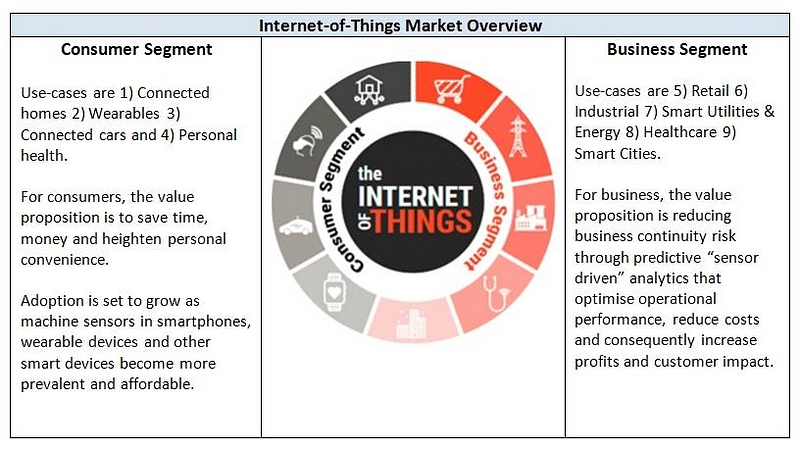
Source: Growth Enabler Market Pulse Report 2017
The IoT market has both business-to-business and business-to-consumer implications. Industrial IoT (IIoT) will be a significant part of the market. This segment of the market includes self-optimizing production, automated inventory management, remote patient monitoring, smart meters, track and trace, connected cards, distributed generation and storage, fleet management and demand response, all of which can be achieved by using “sensors, computers, robots and other machinery that interact with each other and their environment over a network, transmitting real-time data that, with the aid of an analytics platform, can be used to improve manufacturing processes.” Statista predicts that Industrial manufacturing will increase from $472 billion in 2014 to $890 billion in global IoT spending in 2020. Healthcare and life sciences are projected to increase from $520 billion in 2014 to $1.335 trillion in 2020.
Marcus Torchia, research director, Customer Insights & Analysis says Consumer IoT (CIoT) “spending will reach $62 billion in 2018, making it the fourth largest industry segment.” The “leading consumer use cases will be related to the smart home, including home automation, security, and smart appliances” Telecoms and Computing Market Research Reports says the consumer IoT market is set for tremendous growth over the next five years with unit sales to jump nearly fivefold from 366 million in 2016 to 1.8 billion in 2021. The installed base of active consumer IoT devices will exceed 4.6 billion in 2021. The smart home will be the largest contributor to this growth, representing 80% of unit sales in 2021.
Although many big tech firms are already implementing an R&D and marketization strategy for all the various segments of the IoT industry, most startups have mainly focused on only one or two specialized areas (i.e., becoming a VR company or a niche AI company). However, we are starting to see a small shift in this thinking with new companies seeing beyond the silos and designing cohesive strategies around multiple areas of IoT technologies. Most of these startups are planning for an exit strategy that involves being purchased by a big company such as Amazon, which has pretty important consequences for who controls the current $1 trillion market (business computers and software), as it grows to include IoT devices.
Within the United States, Seattle is positioned to be the leading IoT development hub. It is already the leader in cloud computing with the headquarters of both Amazon Web Services and Microsoft located there. States such as North Carolina, Indiana, Illinois, Wisconsin, and Massachusetts are putting strategies in place to be competitive with Washington. Globally, Asia is making a major investment in IoT research and marketization.
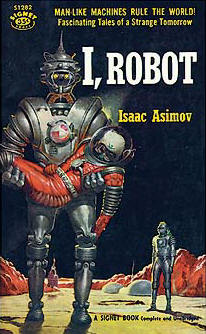
Media makers and authors have been preparing for the advent of connected things for decades, with dystopic visions of robots, intelligent homes and driverless cars dominating both pulp and contemporary science fiction narratives: from Asimov’s laws, to the decades-spanning Terminator franchise, to the tragic and sentient denizens of HBO’s Westworld. However, positive visions are few and far between. We need a wider range of storytellers to not only warn us of the dangers of IoT, but the possibilities beyond the consumer marketplace that these technologies offer for human connection and enlightenment.
The Making a New Reality research project is authored by Kamal Sinclair with support from the Ford Foundation JustFilms program and supplemental support from the Sundance Institute. Learn more about the goals and methods of this research, who produced it, and the interviewees whose insights inform the analysis.
Immerse is an initiative of Tribeca Film Institute, MIT Open DocLab and The Fledgling Fund. Learn more about our vision for the project here.